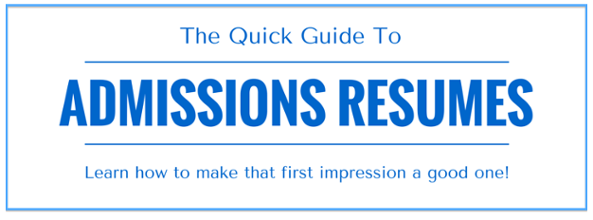
Question #1: Who are you?
Our blog series, 12 Terrific Tips, offers specialized advice for MBA applicants in a range of situations – from deciding between an MBA and EMBA program, to applying as a member of an overpopulated sub-group, to acing your interviews…and loads more. Here’s the final post!
Your MBA resume essentially serves as your career's "greatest hits." On 1-2 pages, you're given the opportunity to highlight your most impressive academic and professional experiences.
Answer these 5 questions to create a stunning resume that’ll grab the attention of top b-school adcom and boost your chances of getting accepted:
1. Who are you?
Interview yourself and examine the jobs you've had, the skills you've acquired, and your “greatest hits” as a professional.
What are some of your most impressive skills or talents? What accomplishments are you most proud of? What have you achieved that gained you the most recognition? How have you impacted your organization or influenced coworkers? What are some of your key successes?
Look through old emails that may jog your memory, read performance reviews or LI recommendations, and jot down some notes chronicling your career achievements.
2. Where are you applying?
The best way to convince the adcom that you’re best for their school is to understand the school’s mission, strengths, and ideals.
When putting together your resume, you'll need to learn as much as possible about the program you’re applying to. Then, customize your resume to reflect the aspects of your background that are most relevant to your target school.
Note: You want the language of your resume to match the school's mission/strength/ideals, but be sure that you're not just parroting back what's on their site. Your goal is to internalize their vision and present your complementary ideals, not to cut and paste or directly mimic their language.
3. What are some of your specific accomplishments?
Saying that you "led your team to success" just won't cut it. Impact is measured in numbers, so you want to make sure that your resume's numbers are high.
Details matter. Look how much more impressive something like this sounds: “Designed $3 million IT strategy that increased revenue by 11% and attracted 7 new clients” compared to "Developed IT plan that was selected for implementation.” If you work for a private company and can’t disclose revenue figures, refer to percentage increases or improvements or cite the improved industry ranking of the organization’s product or performance as a result of your contribution. Think of numbers and other hard details as proof that you can deliver.
4. Are you being honest?
If you dropped out of your CPA course just before finals, don't say that you completed the course. If you were one of eight equally ranked members of a team, don't say you were team leader. If you worked for four months at a company, don't say you were there for a year.
You get the point.
Making up degrees, accomplishments, and other personal and professional facts is just a bad idea. Don’t do it – it’s unethical and potentially self-destructive. Schools won’t hesitate to show students the door when they learn that their resume, or any other parts of their application for that matter, are more fiction than fact.
5. Does your resume look good?
Yes, it's important that your resume sounds good. But how does it look?
A slapdash job will portray you as a sloppy, careless person. A featureless, plain display will make you look uninteresting or boring. The solution here isn't to create a hot pink background bordered by birds and flowers; but adding a few design elements will do wonders to spruce up your resume and show that you put some thought into your presentation.
A few suggestions:
• Instead of the traditional circle bullet or dash, use the less common diamond- and arrow-shaped bullet.
• Use expanded text (kerning) to highlight a key term.
• Enclose certain sections of your resume in shaded boxes.
No matter what you, keep in mind that less is more – you don't want a cluttered resume that will be difficult to read. And if your target school specifies format rules (particularly regarding margins, page number, and font), be sure to follow theirs to a T. This may mean toning down your creative flair for design to fit their standard.
Related Resources:
• Twelve Terrific Tips for MBA Applicants [free guide]
• Six Tips For Better Resumes
• 9 Do’s And Don’ts For Your Application Resume
This article originally appeared on blog.accepted.com.
Applying to a top b-school? The talented folks at Accepted have helped hundreds of applicants get accepted to their dream programs. Whether you are figuring out where apply, writing your application essays, or prepping for your interviews, we are just a call (or click) away.
Contact us, and get matched up with the consultant who will help you get accepted!


